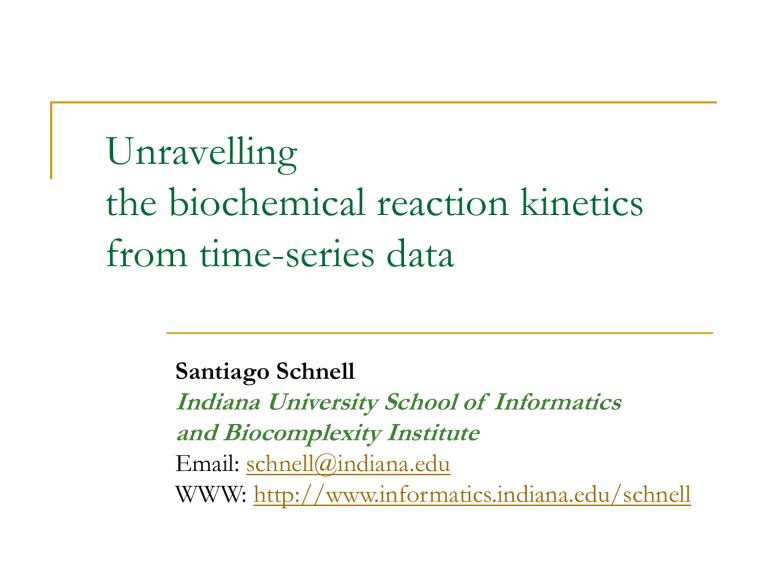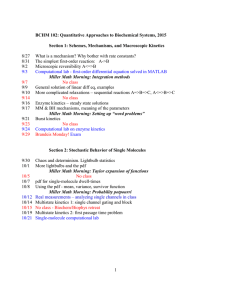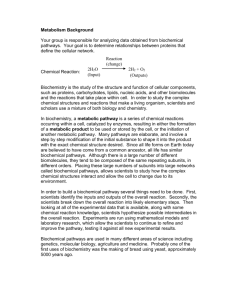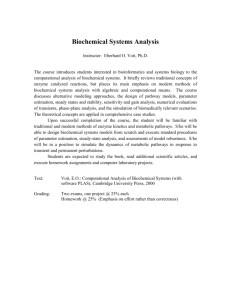Unravelling the biochemical reaction kinetics from time-series data

Unravelling the biochemical reaction kinetics from time-series data
Santiago Schnell
Indiana University School of Informatics and Biocomplexity Institute
Email: schnell@indiana.edu
WWW: http://www.informatics.indiana.edu/schnell
Achievements of the biomedical sciences
The identification and structural characterisation of molecules.
The determination of rate constant for large number of biochemical reactions and physiological interactions.
The design, construction and synthesis of molecules. The study of their physiological effects.
Identification of the reaction mechanism
However, it is not until recently that some progress has been made on dissecting a complex biochemical/physiological mechanism into its key components.
Classical approach for determining the reaction mechanism
Identify the primary stoichiometry of the overall reaction.
Compile a list of chemically plausible species.
Break down the overall reaction into likely elementary steps.
Assemble all relevant experimental data available.
Put all the thermodynamically plausible steps and the corresponding kinetics data together to form a trial mechanism.
Use numerical methods to simulate the experimental results.
Continue to refine and improve the mechanism, testing it against all new experimental results.
Changes in biomedical research
Traditional labour intensive! Hypothesis testing
High throughput measurements, -omic technologies, databases: data-driven modelling
Experimentation is now non-hypothesis driven
Changes in biomedical research
Oimics Science
While there is a wealth of genomics , proteomics and microarray data available today, we still have more questions than answers when it comes to understand the functions of genes and proteins and their downstream effects on the behaviour of a cell or an organism.
Limitation of –oimics data
While the high-throughput experimental assays would have been unimaginable in the era preceding genome sequencing, an protein interaction map doesn't get us close to one key aspect of biology: dynamism.
Fundamental problems in biomedical sciences
One of the most profound surprises arising from the sequencing of different species ’ genomes is the degree of similarity among sequences:
We see this similarity not only in
the numbers of protein-coding genes, and
the degree of homology between genes belonging to different species, but also in
the organization of genes and in their regulation.
Fundamental problems in biomedical sciences
Even when full genomic sequences for an organism are available, the functions and interactions of only a small number of gene components are clear.
•
For humans, a function is known for 3-5% of the genes.
•
For the well-studied E. coli, more than 60% of the genes have a known function.
As we understand the gene functions, we can better predict and control their responded to perturbations.
Possible outcomes of functional genomics
Similar sets of genes in different developmental programs
Different organisms hook up in different ways
Kinetic properties of biological pathways may be determinants important in differentiating among the products of different genomes.
Biochemical pathway inference methodologies under consideration
Models to investigate reaction mechanisms from time course data:
•
Impulse-response method
•
Distribution-delay method
•
Time-series analysis
Unravelling the reaction
Why kinetic models?
Biological processes are time dependent
Sequence of events (causality)
To understand regulatory mechanisms
Over 25 years of kinetic modelling and experimental work on biochemical reaction networks
Principles for biochemical kinetics pathway modelling
Identify the flow of mass between variables.
• Irreversible and reversible processes
E + S ↔ C → P + E
• Open and closed reactions
→ S
1
↔ S
2
↔ S
3
→ S
1
↔ S
2
↔ S
3
• Stoichiometry
2 X → A + P X + Y → 2 P
Principles for biochemical kinetics pathway modelling
Identify stoichiometry in the pathway.
Stoichiometry of the reactions
A → C + D
A + B → C + D
A + B + M → C + D
Principles for biochemical kinetics pathway modelling
For each variable X i that changes over time, define an equation that relates its change over time to influxes and effluxes.
Change in X i
= Fluxes into X i
- Fluxes out of X i
The change is equivalent to the derivative of the variable X i with respect to time: dX i
/dt
Principles for biochemical kinetics pathway modelling
Writing the rate equations.
In general, we can write
X
1
X
2
X
3 d X
2 d t
v
1
v
2 where v
1 and v
2 depend on the chemical kinetics of the reaction.
Principles for biochemical kinetics pathway modelling
Law of mass action
X
1
A X
2 d X
2 d t
k
1
X
1
A
v
1 k X v
2 where k
1 and k
2 are rate constants.
X
3
Impulse-response method
Domino-effect analysis
A qualitative form of impulse response analysis can be used to gather information connectivity on of the a biochemical reaction pathway, which can be pieced together to determine the network connectivity, and in some cases the entire wiring diagram.
Impulse-response method
Peaks can be quantified determining the response timescale of the species.
Limitation of the impulse-response method
For complicated networks, the responses are harder to interpret and the network more difficult to reconstruct.
The impulse-response diffuses with the
“ distance ” from the perturbed species.
The method requires to known all the species involved in the reaction.
Distribution delay method
In this approach, we consider a reaction network as follows:
Reactants
Products
Distribution delay method
From the mathematical point of view, a reaction with delay can be written:
X
1
X
2
X
3 d X
2
( t )
k d t
X ( t
synthesis
)
k X ( t ) decay where
is the delay in the reaction.
Distribution delay method
The distribution of delays can tell us about the number of intermediates and the size of rates constants.
The distribution of delays can also tell us about the topology of the network.
Limitation of the distribution delay method
We found that the form of the distribution delay is characteristic for each reaction mechanism.
However, a particular distribution of delays does not give a unique reaction mechanism.
Distribution of delays can be employed to determine the conditions under which a number of reaction mechanism are equivalent.
A potential difficulty:
Indistinguishable reactions
Example
In 1902, Victor Henri proposed two mechanisms for the enzyme action:
I E + S ↔ C → E + P
II C ↔ E + S → E + P
The reduce system describing these reaction is: d [ S ]
[ E
0
]
[ C ]
[ S ]
[ C ] d t d [ C ]
[ E
0
]
[ C ]
[ S ]
[ C ] d t where
,
,
and
are constants
Time series analysis
In this type of analysis, we try to solve the reverse problem: from the time course data, we would like to fit an expression for the reaction kinetics.
Let us suppose that reaction system governing equation of the chemical species is represented by a polynomial model structure of order p .
d x i d t
F i
( x , a i
)
a i
j
K
1 b ij x j
K j
K
1 k
1 c ijk x j x k
Then, we apply an interative approach to model selection.
Simple-to-General, or General-to-Specific?
How the researchers are divided!
Simple-to-General General-to-simple
Setting the cost function: minimum description length
Danger of over fitting
Avoid by choosing a Cost function to assess
“goodness of model” which penalises use of many terms
Consistent with Sparseness ideas for some biological networks
Dealing with biological complexity:
Using prior knowledge
For time series analysis approaches the key is to adapt them to incorporate biological knowledge. This can be done by
Starting with a partial model
Favourably weighting suspected reactions and interactions
Fixing known interactions
The pros and cons
Simple-to-general approach model building is a divergent branching process, this favours general-to-specific approach.
The general-to-specific approach is very slow as the number of species increases, particularly for polynomial type expressions.
Limitation of the time series analysis
Most of the methods proposed require to measurement of the concentrations of all the species. This conditions cannot be met in practice.
Most of the techniques involve monitoring the concentration relaxation after a perturbation very close to the equilibrium state.
The mechanisms deduced by these methods follow pseudo-firstorder kinetics.
The determination of the mechanism by time series analysis does not afford unique solutions.
There are reaction mechanisms that can be kinetically indistinguishable by time series analysis!
FIN






